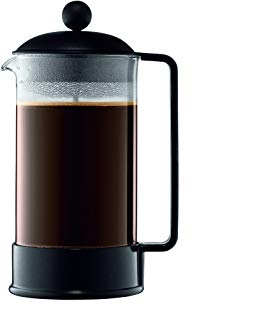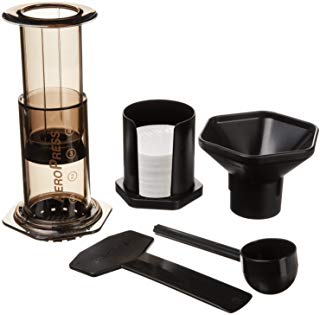Table of Contents
Making coffee
With Propane
(or other fuel)
Like with almost all cooking in a van (and anything to do with generating heat), making coffee is much easier when using propane. Heating water on a camp stove uses no electricity, although it does require a bit more labor.
Steeping
 The french press is the most famous of the steeping coffeemakers. They can be challenging to clean in a van galley and many are made of glass, but if coffee is that critical to your existance Jetboil makes a french press kit that runs off of the common propane cylinders
The french press is the most famous of the steeping coffeemakers. They can be challenging to clean in a van galley and many are made of glass, but if coffee is that critical to your existance Jetboil makes a french press kit that runs off of the common propane cylinders
 The aeropress has many RV fans because it is small and made of plastic.
The aeropress has many RV fans because it is small and made of plastic.
joshrice says:
cut the bottom off of a koozie and you can slide it around the [aeropress] to help keep it warm in the cold!
Pour-over
Pour-over coffee makers are cones that hold a filter and grounds. Hot water is poured over them usually in a few doses. Melitta is the most famous one. They are typically made of unbreakable plastic and are relatively easy to clean.
With electricity
Electric coffee makers are possible, but are best used when connected to shore power. They use a lot of power, particularly for boondockers.1)
| Small drip | pod | |
| avg watts | 740 | 1200 |
| inverter ineff. | 74 | 120 |
| total watts | 814 | 1320 |
| Amps (W/13) | 62.6 | 101.5 |
| Ah per 5min use | 5.2 | 8.5 |
To compound the problem, coffee is usually brewed in the early morning when batteries are most deeply discharged. This early morning load is bad enough for an MPPT-charged system but it hamstrings a PWM-charged system (for reasons explained here).
If you run a generator in the morning, that is a great time to use an electric coffeemaker.
Heating the absolute minimum amount of water needed is a good way to conserve usage. One option is a 12v hot water bottle such as https://www.amazon.com/gp/product/B00JSOOD6Q
without heat
Cold-brewed coffee brews overnight in the cooler or on the counter. It is reported to be smoother and less acidic, but may require more grounds to achieve the same amount of flavor.
- pour grounds into a quart or other jar
- fill jar with water
- allow to sit 8-24 hours
- pour coffee through a sieve, discarding the muddiest bits at the bottom of the jar
- rinse the jar and sieve
- pour coffee back into jar through filter sitting on the sieve
other considerations
Space and other constraints might work against otherwise-acceptable coffeemakers.
- will this fit in my van? On my counter?
- if electric, do I have a big enough inverter to run it?
- how easy will it be to clean without a sink and running water? Can I fit my hand into it?
- does it require special/proprietary parts?
economics and logistics
{Note: this section is for casual coffee drinkers, people (who in the examples below) drink Folger's like mom used to make. If you grind your own beans, have an espresso machine, or detect notes of toffee and zebra mane in that estate Ethiopian you can skip this section. ![]() – secessus}
– secessus}
TL;DR
Coffee commonly comes as whole or ground beans (as you find in cans), freeze-dried instant, and k-pods. Objectively they vary considerably in physical bulk, weight and cost per serving. Subjectively they vary in flavor, ease of making, ease of cleaning, amount of water used, etc.
cost per serving
Using Folger's non-sale prices in the cheapest (bulk) unit price at Walmart as of the time of this writing:
From most expensive to least expensive, per tall cup (500ml / ~17oz)
- $1.33 - pods for use in Keurig-type devices
- $0.35 instant coffee “singles” (individual packets)
- $0.31 - ground coffee
- $0.18 - instant coffee in jars
In bulk the most extensive option is about 7x the cost of the least expensive. In general ground is about 2x as much as instant, although the giant 40oz Folgers “tallboy”2) brings it down to 1.72x.
bulkiness and storage
Crude math done by Secessus on coffee containers in his van suggests ground coffee takes >3.5x more space (volume) to store per cup of coffee
If we assume a smaller packages for 'dwellers the price difference is even greater:
- $1.88 - pods (12 pack)
- $0.47 - ground coffee (10oz) Note: while not so available as they once were, 10oz vacuum-packed “bricks” can be less expensive.3)
- $0.35 instant coffee “singles” (no bulk available)
- $0.18 - instant coffee (12oz)
In sizes vanfolk are more likely to carry with them the most expensive option is about 10x the cost of the least expensive.
weight
Using the assumptions above, ground coffee weights >5x more than instant. Keurig cups add additional per-dose packaging weight.
equipment bulk
Assuming we already have a water kettle for non-coffee purposes, from bulkiest to tidiest:
- Keurig or drip machine
- press
- pour-over
- spoon (to stir instant)
If one has a dedicated kettle for boiling coffee water then the advantages above disappear.
water consumption
Instant coffee will use the least amount of water: all the water used will be consumed. Ground coffee, whether loose or in pods, will retain some amount of water. It's not a lot, but included for the purposes of completeness.
Of the methods above, the a french press will likely require the most water for equipment cleaning. The other methods can probably be rinsed lightly.
power consumption
Only the Keurig and drip coffeemakers require electricity. Water for press, pour-over, and instant can be boiled over propane or gas stoves.
Since it takes the same amount of power to heat a given amount of water there is likely little difference in brewing power consumption between Keurig and drip. Secessus has noted 70Wh4) for drip brewing 500ml of coffee. For comparison, he observed ~111Wh for kettle on a coil hotplate, ~67Wh for a kettle on induction, and ~135Wh for percolator on hotplate.5)
Instant coffee can be made at drinking temperature6) rather than brewing temperature because it has already been brewed.
trash
Note: this section is about dealing with trash in the vehicle, not necessarily ecological effects.
From most garbage produced to least (assuming we can dispense of used grounds in nature)
- pods
- ground coffee filters and can, instant “singles” pouches
- instant coffee jars
Of these only the pods are egregious. Coffee cans and instant jars can be used as trash containers themselves (see link above) and filters and instant pouches compress nicely into such containers. Coffee filters might be tossed into an existing campfire.

